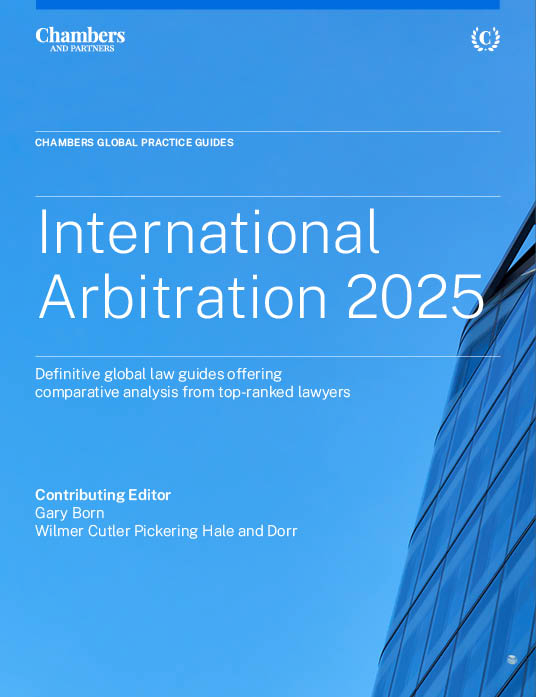
International Arbitration 2025
The International Arbitration 2025 guide covers close to 60 jurisdictions. The guide provides the latest legal information on global arbitration practice and trends, including governing legislation, arbitral tribunals, challenges to jurisdiction, preliminary and interim relief, collection and submission of evidence, confidentiality, types of remedies, enforcement and review of awards, class actions, and third-party funding.
Last Updated: August 21, 2025
Compare law and practice by selecting locations and topic(s)
Select Locations

Select Topic(s)

Please select at least one location and one topic to use the compare functionality.
Global Overview – International Arbitration 2025
The international arbitration landscape continues to be dominated by macroeconomic and geopolitical factors. After a series of economic shocks in recent years, the global economy is facing a new threat: a burgeoning trade war thrown into sharp relief following the announcement of sweeping US tariffs in April 2025.
Since then, some tariffs have been put on pause, but the global economic landscape remains dominated by a profound sense of policy uncertainty, growing concerns over slower growth in major economies, and global inflationary pressures that have proven to be more persistent than originally anticipated. Macroeconomic uncertainty has combined with geopolitical events (including the rise of nationalism and protectionist policies, the use of sanctions against Russia and the Middle Eastern crisis) to present serious supply chain challenges and create a highly volatile and uncertain business environment.
This has led to a proliferation of disputes across a wide range of sectors. The areas that are seeing the most disputes are construction, mining, transport and energy; ones in which arbitration has historically been the preferred dispute resolution mechanism. Against this backdrop, it is unsurprising that most leading arbitral institutions reported a record – or close-to-record – caseload over the past year in terms of both the number of disputes referred to arbitration and the value of those disputes.
The Russia-Ukraine War and Israel-Iran War
As the world began to emerge from the pandemic, the Russian invasion of Ukraine on 24 February 2022 triggered another large-scale humanitarian crisis. The Russia-Ukraine war, which has continued into 2025, has caused a massive upheaval in people’s lives and businesses across the globe.
The effect of Russia’s invasion of Ukraine on the arbitration landscape has changed over time. Initially, in 2022, there was a sharp decline in the number of Russia-related arbitrations as reported by the London Court of International Arbitration (LCIA) and other major institutions. The ensuing disruptions, however, have triggered a large number of Russia-related disputes. This is because, since the invasion, many businesses have been forced to cease operations in Russia or have seen their operations taken over by the Russian government.
Since then, several large companies including Carlsberg, Fortum and Uniper either commenced, or confirmed that they intend to commence, treaty claims against Russia for expropriation. The Russia-Ukraine conflict has also triggered a large number of commercial arbitrations, especially in the mining, commodities and energy sectors as Russia’s invasion of Ukraine and the ensuing sanctions has made the performance of numerous existing commercial contracts more difficult and, in some cases, impossible. This has resulted in a wave of commercial arbitrations as parties seek to enforce, suspend or terminate Russia-related contracts. In 2025, Naftogaz, Ukraine’s largest national oil and gas company, and Net4Gas, the Czech Republic’s gas transmission system operator, secured billion-dollar awards against Gazprom over its failure to make monthly payments under their gas transportation contracts.
Global sanctions against Russia and the anti-arbitration stance of the Russian courts have created complications for parties bringing claims against Russian sanctioned entities. Article 248 of the Russian Arbitrazh Procedure Code grants Russian courts exclusive jurisdiction over disputes involving sanctioned Russian entities. In 2024, it was invoked over 200 times to override exclusive jurisdiction clauses and/or to issue anti-arbitration injunctions. This stance has resulted in courts in both common and civil law jurisdictions ordering anti-suit relief against Russian proceedings.
In June 2025, the conflict between Israel and Iran escalated into a full-scale military confrontation as geopolitical tensions resurfaced in the Middle East. The military confrontation has caused supply chain disruptions as shipping, flight and trade routes were suspended and many UAE-based businesses activated contingency measures. These disruptions are likely to trigger a new wave of international trade-related disputes that will be referred to arbitration.
Technology and Generative AI
Investment in technology and AI continues to boom as companies have invested heavily, especially in the use of generative AI. This is having obvious and profound effects on the arbitration landscape.
Many major arbitral institutions are either already using AI, or considering it, for services including vetting and conflict checks, transcription and award scrutiny. There have not yet been any reports of tribunals using generative AI to assist with drafting awards, or preparing case summaries, and the extent to which tribunals may rely on AI remains controversial.
A number of initiatives have emerged to address the use of AI in international arbitration. The most notable are the Guidelines on the Use of AI in Arbitration (2025) published by the Chartered Institute of Arbitrators, and the JAMS AI Rules published in April 2024. Another key, related development is the EU’s AI Act, which entered into force on 1 August 2024, and is the world’s first comprehensive AI law that provides for EU-wide rules on data quality, transparency, human oversight and accountability.
Together with an increased use of AI in the arbitral process, there has been a rise in technology and AI-related arbitrations. This increase is driven by the rapid growth of the tech industry and the increasing reliance on ever more complex technologies and AI across a range of industries. According to recent statistics, information and communication-related technology disputes now represents around 10% of the caseload of the International Centre for Settlement of Disputes (ICSID). Examples of such disputes include Chinese telecoms giant Huawei’s treaty claim against the government of Sweden over its exclusion from the 5G network and Uber’s dispute with Colombia. Investor-state technology disputes of this nature are likely to raise a host of new and topical issues including whether digital assets, blockchain, AI or decentralised assets qualify as investments.
Caseload of Arbitral Institutions
Arbitration continues to remain a preferred method of dispute resolution for many international businesses. A number of arbitral institutions recorded high numbers of new case filings. The International Chamber of Commerce (ICC) registered 841 new arbitrations in 2024, with a total of 1,789 cases being administered by the ICC Secretariat. Singapore International Arbitration Centre (SIAC) recorded 625 new case filings. Other institutions also recorded sizeable numbers with 362 new cases for the LCIA and 503 for the Hong Kong International Arbitration Centre (HKIAC).
The five most preferred sets of arbitral rules are the ICC, SIAC, HKIAC, LCIA and UNCITRAL Rules according to the Queen Mary University of London and White & Case International Arbitration Survey, a recurring feature of the arbitration landscape that the industry has now grown used to seeing as a periodic barometer of its progress. In the most recent survey, the most preferred arbitral seat is London, with users citing the stability of its commercial law and highly regarded judiciary. Singapore was the second most popular seat, with users noting that it is receiving a larger share of Asian disputes as many US and Western companies have relocated out of Hong Kong.
The Reform of the Arbitration Act (England and Wales)
In the UK, the process of reform of the Arbitration Act 1996 has reached its conclusion as the Arbitration Act 2025 entered into force on 1 August 2025.
By far and above the most reform of the Arbitration Act 2025 is to introduce a new statutory rule that, in the absence of an express choice from the parties of the governing law of the arbitration agreement, the applicable law will be the law of the seat. This reform overturns the effects of Enka v Chubb, a Supreme Court decision of October 2020 that decided the vexed question of how to determine the law applicable to an arbitration agreement. In Enka v Chubb, the Supreme Court held that the default choice is the law of the contract. This is significant because, where an arbitration agreement is governed by foreign law, key provisions of the Arbitration Act 1996 do not apply, with the result that parties are deprived of the full protection and support of the English courts for arbitrations seated in London.
The Arbitration Act 2025 now provides welcome clarity to the choice of law applicable to arbitration agreements by implementing a straightforward statutory rule that the arbitration agreement is governed by the law of the seat, absent an express choice of law. As a consequence, parties who choose London as an arbitral seat – absent an express choice of law applicable to the arbitration agreement – now know that any dispute as to the scope or validity of the arbitration agreement will benefit from an arbitration-friendly jurisdiction, offering a robust legal framework that supports and facilitates the arbitration process, and where arbitration agreements are respected and enforced.
Other key changes include the strengthening of arbitrator powers to make awards on a summary basis and to issue peremptory orders and a codification of the arbitrator’s duty of disclosure.
New Arbitral Rules
In 2025, the SIAC introduced new arbitration rules. One of the key changes in the SIAC Rules 2025 is to enhance its emergency arbitration procedure by permitting an emergency arbitrator to order ex parte interim relief. SIAC is one of the first major arbitral institutions to permit an emergency arbitrator to order interim relief on an ex parte basis. Other key changes include: (i) new rules on third-party funding to give tribunals wide-ranging powers to require details of third-party funding arrangements, (ii) a new “preliminary determination” procedure and (iii) a new “streamlined procedure” for disputes of low value. These new provisions all improve the time, cost-efficiency and attractiveness of SIAC arbitration.
In 2024, the HKIAC approved a new set of rules. These rules are noteworthy for the additional powers and duties they confer on the HKIAC. Under the 2024 Rules, the HKIAC may “take any measure necessary to preserve the efficiency or integrity of the arbitration”. This includes powers to suspend or cease administration of the arbitration and, in exceptional circumstances, to revoke an arbitrator’s appointment if the HKIAC concludes that an arbitrator has failed to fulfil their function. The new HKIAC Rules also contain new provisions addressing information security, the environmental impact of legal proceedings, multi-contract scenarios and additional powers for emergency arbitrators.
The Saudi Center for Commercial Arbitration (SCCA) issued a new set of updated rules in 2023. Importantly, the 2023 Rules provide for the establishment of an SCCA court to perform an administrative role to support arbitrations that are administrated under the SCCA rules. The SCCA also provides for an online dispute resolution system for the resolution of low-value disputes as well as an electronic filing system. The 2023 Rules are some of the most advanced rules in terms of embracing the use of modern technology to improve the efficiency of the dispute resolution process. The Kingdom of Saudi Arabia followed up by issuing an updated Investment Law in 2024 that facilitates the establishment of foreign investments in Saudi Arabia. More recently, in 2025, the Council of Ministers of the Kingdom of Saudi Arabia approved a resolution to strengthen and modernise the country’s arbitration laws and promote Saudi Arabia’s attractiveness as a sophisticated and arbitration-friendly seat in the Middle East. All these measures are intended to provide an attractive investment climate for foreign investors.
The Shanghai International Economic and Trade Arbitration Commission (SHIAC), a leading arbitral institution in the PRC, introduced new arbitration rules with effect from 1 January 2024. The 2024 Rules provide for emergency arbitration and interim relief, expanded provisions on joinder and consolidation, online arbitration using SHIAC’s e-platform, and for the publication of awards with party consent.
The Development of Arbitral Jurisprudence
National apex courts have recently delivered several judgments that have had a meaningful impact on the development of arbitral jurisprudence. Perhaps the most prominent of these that captivated the attention of the arbitration community were rendered by the UK and US Supreme Courts.
CC/Devas (Mauritius) Ltd v Antrix Corp. Ltd
In June 2025, the US Supreme Court issued a significant decision with respect to the federal court’s jurisdiction over the enforcement of foreign arbitration awards against a sovereign under the Foreign Sovereign Immunities Act (FSIA). The Supreme Court overturned the Ninth Circuit’s decision and held that, under the FSIA, personal jurisdiction exists over a sovereign entity when “an immunity exception applies and service is proper”. In reaching this conclusion, the Supreme Court held that the FSIA does not require a showing of “minimum contacts” with the jurisdiction in which enforcement is being sought to establish personal jurisdiction as set out in the International Shoe v Washington line of cases. The decision reflects the US courts’ long-standing pro-arbitration stance and a reluctance to impose restrictions on enforcement actions.
Smith v Spizziri
The US Supreme Court held that federal courts must stay, rather than dismiss, claims that are governed by an arbitration agreement. The decision is important as while a party can immediately appeal an order dismissing an action, there is no immediate right of appeal from an order staying the proceedings. The decision resolves a circuit split over whether Federal Arbitration Act, 9 U.S.C. § 3 requires a court to stay proceedings after compelling arbitration. The Supreme Court’s pro-arbitration decision reasoned that staying, instead of dismissing, lawsuits subject to an arbitration agreement is consistent with the supervisory role that the Federal Arbitration Act envisions for the courts and allows parties to seek relief related to the arbitration without filing a new case.
Morgan v Sundance
Morgan v Sundance addressed the important question of the standard for determining whether a party has waived its right to arbitrate a dispute by first engaging in litigation. Overruling decisions in nine circuits, the Supreme Court unanimously held that there is no requirement for an adverse party to show that it suffered prejudice as a result of the litigation proceedings for a waiver of a right to arbitrate to arise. The decision is important and may have wider ramifications because the Supreme Court reasoned that arbitration-specific procedural rules – such as a prejudice requirement – are incompatible with the FAA, even when those rules purport to support the pro-arbitration policies underlying the FAA.
ZF UniCredit Bank GmbH v RusChemAlliance
The UK Supreme Court confirmed that English courts have the discretion to issue anti-suit injunctions to support foreign seated arbitrations where English law governs the arbitration agreement. Prior to this decision, the circumstances in which English courts would grant injunctive relief to support foreign-seated arbitrations were uncertain. This decision is important as it confirms that parties can request an anti-suit injunction from the English courts to enforce an arbitration agreement, even where the arbitration is not seated in England and Wales.

